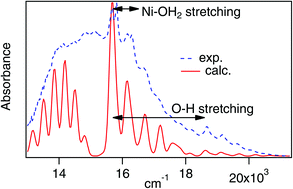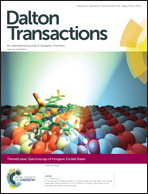Spectroscopic effects resulting from interacting singlet and triplet excited states: vibronic structure involving the O–H stretching mode in d–d absorption bands of Ni(H2O)62+†‡
Abstract
The ligand-field absorption spectrum of the Ni(H2O)62+ cation has been thoroughly measured and analyzed over the past sixty years, often on crystals with low symmetry at the metal site, and its absorption band maxima have been used as a benchmark for increasingly sophisticated electronic structure calculations over the last decades. We present variable-temperature absorption spectra measured on crystals with cubic Th symmetry at the site of the nickel(II) cation. This high site symmetry is confirmed for CsNi(H2O)6PO4 by X-ray diffraction and allows for a direct comparison with ligand-field calculations in Th symmetry, at the basis of an analysis of the vibronic structure in the energy range of the lowest-energy spin-forbidden transition, the “red” or middle band of the spectrum. This spectroscopic region displays effects of strong interactions between singlet and triplet excited states, influencing intensities and vibronic structure. A particular feature that has not been analyzed in detail is a clearly discernible vibronic progression involving the O–H stretching mode on the high-energy side of the absorption band. A quantitative model is presented and applied in order to rationalize this unusual effect, originating from coupling between normal coordinates, to the best of our knowledge the first analysis of this distinct spectroscopic feature arising from interacting excited states.

- This article is part of the themed collection: Spectroscopy of Inorganic Excited States

 Please wait while we load your content...
Please wait while we load your content...